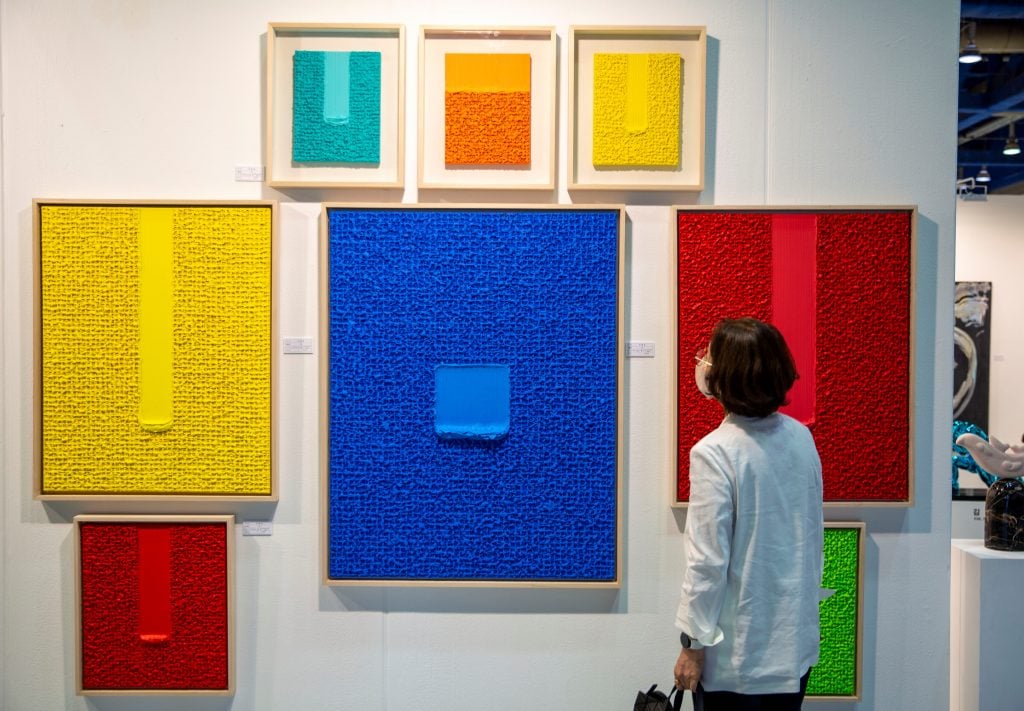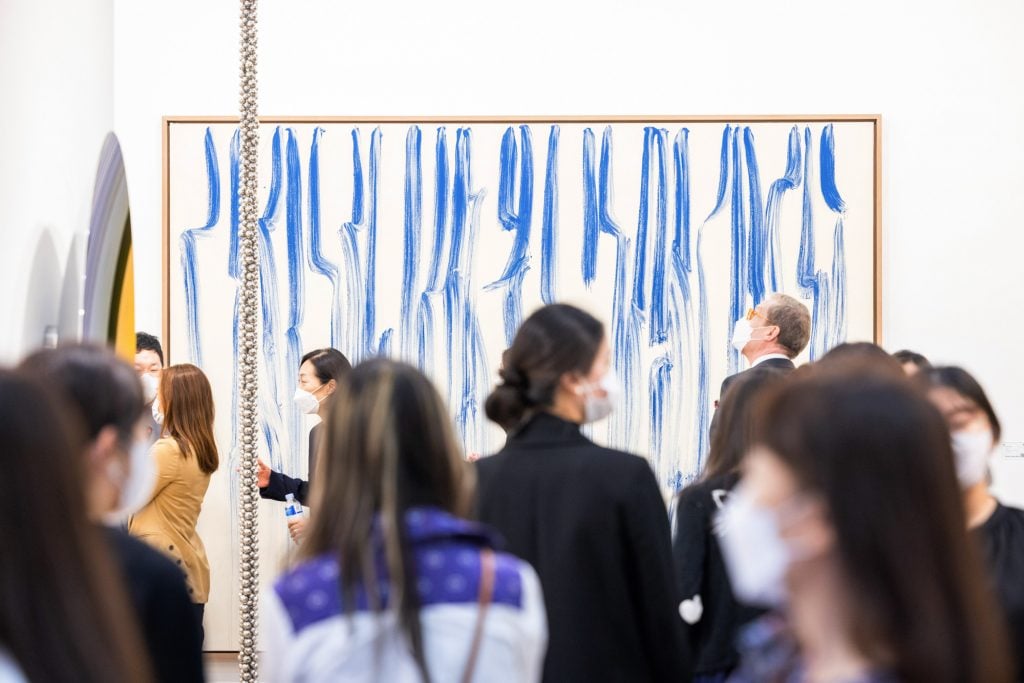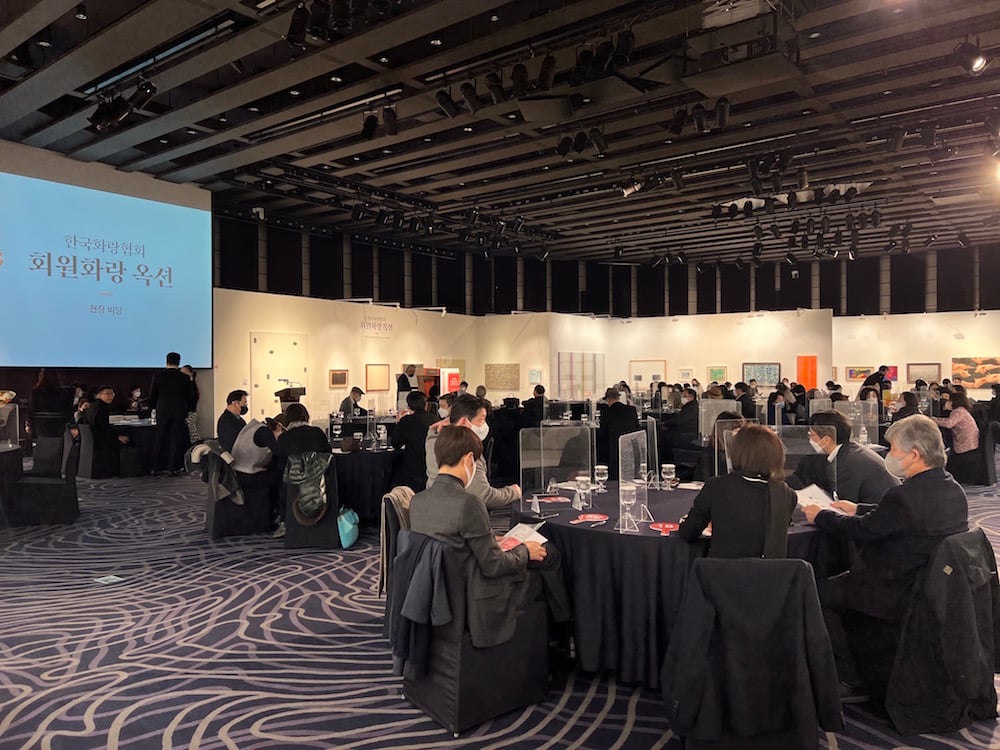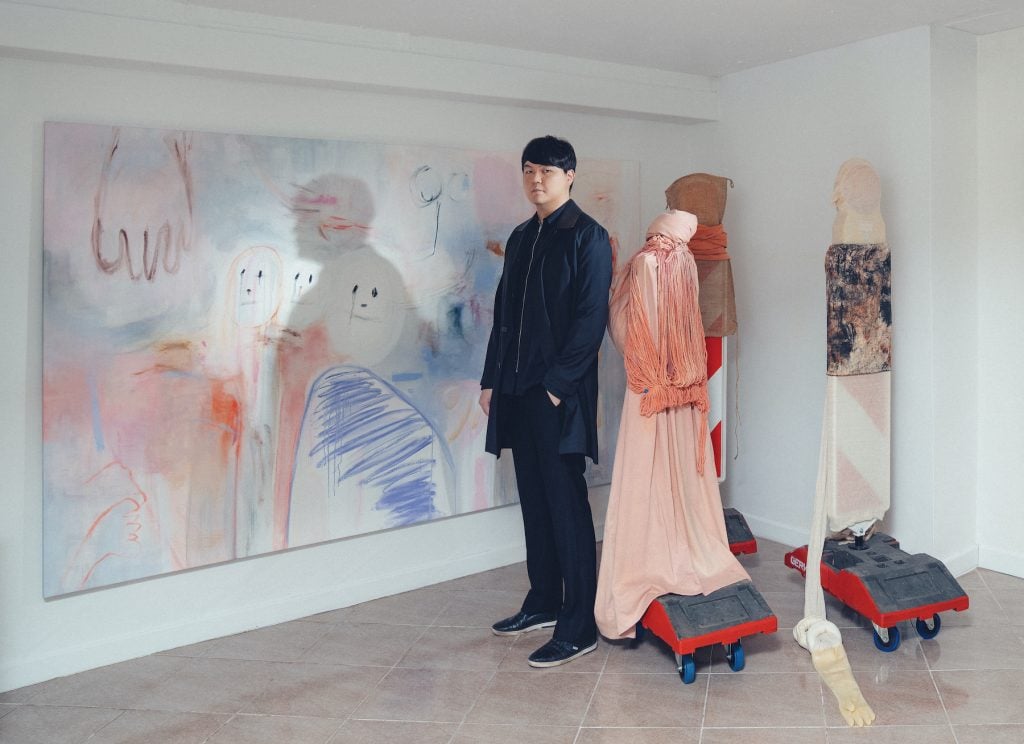Artnet News Pro
Young, Green Collectors Are Driving the Art Market Explosion in South Korea. But Could a Growing Interest in Speculative Buying Be a Slippery Slope?
"It’s not just rich people who are collecting art," said one expert.

"It’s not just rich people who are collecting art," said one expert.

Vivienne Chow

There’s a popular online forum in South Korea called “become an employee collector,” which sees some 17,114 members passionately discussing a range of topics related to art, from exhibition reviews to which artists to see during the week of Frieze and Kiaf fairs in Seoul this week. They discuss art collecting like pros, and yet many claim that they are just ordinary people living on a salary.
These members, active on what are dubbed in South Korea as “cafes,” do not discuss art face-to-face. On the local Reddit-like platform Naver, “Become an employee collector” is merely one of the many art-related discussion forums. Plenty of others are there dedicated to exhibitions, art history studies, art-making, and art investment.
“It feels like collecting art is becoming a culture,” Noh JaeMyung, a 31-year-old South Korean collector and an education entrepreneur, told Artnet News. “Things are really changing in Korea… It’s not just rich people who are collecting art.”
Positive vibes aside, however, there are worrying signs, Noh observed. The experienced collector, who began collecting in his high school days in the U.S., noticed that prices of some artworks do not correspond to their quality, especially in the secondary market. He said some in South Korea buy artworks by certain artists simply because they have seen others buying them. “A lot of people don’t really care about art but they collect because they think art is just an investment. That’s definitely not healthy,” he said.
The art boom, anchored in Seoul, is not necessarily all rosy, a few insiders told Artnet News. Though the data, as illustrated by findings shown in the first part of this Artnet News Pro series, might be pointing to unprecedented growth, this surging young art-buying crowd behind it has little experience in art. Some are concerned this could lead to unhealthy market speculation and the jeopardization of some young local artists’ careers in the long-run.

Kiaf SEOUL 2021. Photo by Kiaf SEOUL Operating committee. Courtesy of Kiaf SEOUL.
The so-called South Korean MZ generation (a popular term grouping the generations of Millennials and Zoomers) of young collectors in Asia are known to move fast and be tech savvy. In many cases, a prolonged exposure to the western art world has given them confidence in buying art. They will reach out to a gallery directly without the need for a third party: they’ll bid at auctions, and make decisions on their own.
“Hence they rely less on advisors and other parties, compared to traditional collectors,” Jeong Seokho, managing director of Art Busan and also a young collector in his thirties, told Artnet News.
There are different types of young collectors entering the market. Some, like Jeong, come from a collecting family (Jeong’s family founded Art Busan and has a family collection). Others entered the market fresh without any art background. “Traditional“ young collectors (from collecting families) are more cautious when it comes to collecting an artwork, but those who started from scratch prefer auctions to galleries.
“Auctions appear to be more accessible and transparent. It’s often difficult to acquire artworks from galleries, as the competition is high and the collector has not yet built a strong collection,” Jeong said. New collectors act fast, he added, saying that he is “often surprised to see many are building their amazing collections in such a short period of time.”

Jeong Seokho, managing director of Art Busan and collector, with Rose Wylie, Yellow Bathing Costume, and 6 Birds (2019). Photo credit: ⓒ Lee Youjin.
New young collectors might not opt for art advisors, but they are keen to learn and take art collecting classes from others. Lee Soyoung, a 38-year-old art-buyer, is offering such courses. An art history graduate and author of nearly a dozen books on art and collecting, Lee told Artnet News that her students range from beginners who are “ordinary, hard working people” to “self-made entrepreneurs in their thirties to forties,” as well as long-time collectors.
“It’s a hobby to appreciate and enjoy culture,” she said, adding that they are not shy to share their collections in her collectors’ salon on Instagram.
But to collectors like Noh, social media could be a slippery slope. He cautioned that some novices are posing as art connoisseurs or influencers on social media, but that ultimately they are just posting pictures of art. Dealers and speculators also frequent “cafe” discussion forums pretending to be collectors when they are actually trying to sell art.
“You could [have your opinion] affected a lot by others on social media,” Noh quipped.
It’s no secret that there has been an ongoing turf war between galleries and auction houses in South Korea, where the galleries had accused auction houses of encroaching on the primary market. But these speculative market activities show no signs of slowing down after a group of galleries in South Korea held a closed-door sale in January to protest against auction houses; the sale featured predominantly young artists.

The Korean Galleries Association auction at the Westin Josun Seoul Grand Ballroom in Seoul on January 26. Image courtesy the Korean Galleries Association.
Data from the Artnet Price Database shows that the total sales value of ultra-contemporary artists (born in 1975 or after) at Korean auctions spiked dramatically in recent years. It was under $73,000 in 2017, and in 2018, it jumped to $252,098. The market then grew to four times that, reaching $1 million in 2020, before skyrocketing to $14 million in 2021. By August this year, the total sales value of this younger cohort of artists already reached $18.7 million.
“We are in an ongoing conversation with the auction houses, asking them to decrease the number of major sales they host,” said Do Hyung-teh, vice-president of the Galleries Association of Korea, which organizes the long-running Kiaf Seoul and is a partner of Frieze Seoul. “Given how closely the primary and the secondary markets are related, it is important that the number of auctions and the quality of each sale is carefully managed in order for the two markets to co-exist in a healthy way.”
Market speculation might not be a totally bad place for someone to begin art collecting with, said Jason Haam, a 31-year-old art collector-turned-art dealer. Young collectors tend to focus on artists who are hot and booming, according to Haam, an approach different from collectors of the older generation. The desire to make money, by nature, is not wrong.
As these young buyers evolve, they should realize that making money in art is very different from other industries “because there are relationships involved,” said Haam.

JaeMyung Noh.
The abundance of western galleries opening outposts in Seoul has given people the impression that young collectors in Korea prefer international art to works produced by local talents. This is true to a certain extent, Noh said. Those who received education in the west grew up with the art world in London or New York, which became their starting point for collecting, and they knew little about Korean art.
Another reason for focusing on international art is risk aversion. “A lot of them think that collecting international artists is safer, compared to homegrown artists because the market is bigger,” Noh noted.
But this is about to change as these collectors, returning from abroad, are incorporating Korean art into their collection. Noh has now added works by young Korean artists such as Hyun Nahm, Choi Jiwon, and Ok Seungcheol to his 150-strong art collection, and he intends to collect more. “I’m Korean and I’m living in Korea. I feel like I should be more supportive to artists from the same country, and I think that’s also a way to make the local art scene a little healthier,” he noted.
Similarly, as an art dealer, Haam hoped to present Korean artists in the future. Since opening his Seoul gallery in 2018, Haam has traveled to many art fairs, including Art Basel in Hong Kong earlier, and he will be participating in Frieze Seoul, but his roster is still full of international artists. He showed Cheikh Ndiaye from Senegal in Hong Kong, and in this week of Frieze and Kiaf, his gallery will be presenting a solo show of the Swiss-born, New York-based Urs Fischer.
He has already begun his search to find Korean artists to work with but finding a fit has not been straightforward for Haam. “There have been many cases of artists who thrive one moment but would completely disappear after five years. People are always skeptical,” he said.
“Perhaps one day a Korean gallery like myself or others will successfully make an international debut for a Korean artist. Unfortunately, there aren’t that many successful examples yet. I want to change that, and I’ll try to change that,” said Haam.